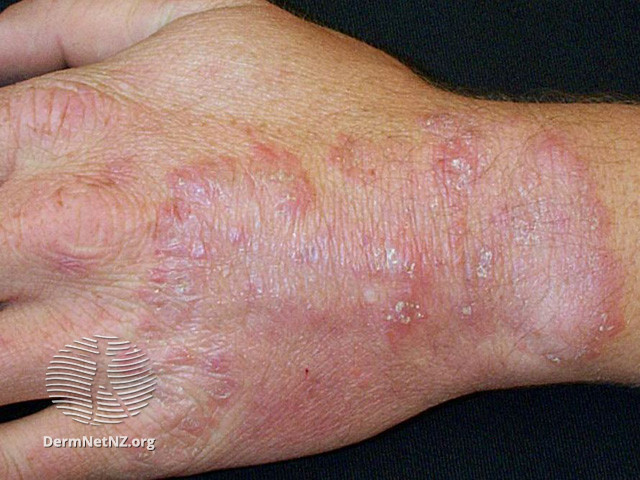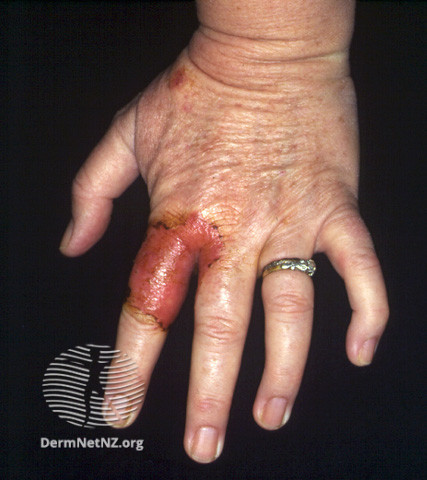[1]
Elewski BE, Greer DL. Hendersonula toruloidea and Scytalidium hyalinum. Review and update. Archives of dermatology. 1991 Jul:127(7):1041-4
[PubMed PMID: 2064405]
[2]
Zhan P, Geng C, Li Z, Jiang Q, Jin Y, Li C, Liu W. The epidemiology of tinea manuum in Nanchang area, South China. Mycopathologia. 2013 Aug:176(1-2):83-8. doi: 10.1007/s11046-013-9673-9. Epub 2013 Jun 14
[PubMed PMID: 23765324]
[3]
Rhee DY, Kim MS, Chang SE, Lee MW, Choi JH, Moon KC, Koh JK, Choi JS. A case of tinea manuum caused by Trichophyton mentagrophytes var. erinacei: the first isolation in Korea. Mycoses. 2009 May:52(3):287-90. doi: 10.1111/j.1439-0507.2008.01556.x. Epub 2008 Jul 11
[PubMed PMID: 18643919]
Level 3 (low-level) evidence
[4]
Daniel CR 3rd, Gupta AK, Daniel MP, Daniel CM. Two feet-one hand syndrome: a retrospective multicenter survey. International journal of dermatology. 1997 Sep:36(9):658-60
[PubMed PMID: 9352405]
Level 2 (mid-level) evidence
[5]
Ogawa T, Ogawa Y, Hiruma M, Kano R, Ikeda S. Tinea manuum caused by Trichophyton erinacei. The Journal of dermatology. 2020 Sep:47(9):e344-e345. doi: 10.1111/1346-8138.15477. Epub 2020 Jun 29
[PubMed PMID: 32602141]
[6]
Watabe D, Takeda K, Amano H. Tinea manuum caused by Trichophyton erinacei from a hedgehog. European journal of dermatology : EJD. 2021 Aug 26:():. doi: 10.1684/ejd.2021.4111. Epub 2021 Aug 26
[PubMed PMID: 34463276]
[7]
Perrier P, Monod M. Tinea manuum caused by Trichophyton erinacei: first report in Switzerland. International journal of dermatology. 2015 Aug:54(8):959-60. doi: 10.1111/ijd.12291. Epub 2013 Dec 30
[PubMed PMID: 24372169]
[8]
Veraldi S, Schianchi R, Benzecry V, Gorani A. Tinea manuum: A report of 18 cases observed in the metropolitan area of Milan and review of the literature. Mycoses. 2019 Jul:62(7):604-608. doi: 10.1111/myc.12914. Epub 2019 Apr 24
[PubMed PMID: 30929271]
Level 3 (low-level) evidence
[9]
Harada K, Hiruma J, Maeda T, Tsuboi R. Case of tinea manuum transmitted by a hedgehog in an animal cafe. The Journal of dermatology. 2019 Oct:46(10):e344-e345. doi: 10.1111/1346-8138.14894. Epub 2019 Apr 24
[PubMed PMID: 31017686]
Level 3 (low-level) evidence
[10]
Walsh AL, Merchan N, Harper CM. Hedgehog-Transmitted Trichophyton erinaceid Causing Painful Bullous Tinea Manuum. The Journal of hand surgery. 2021 May:46(5):430.e1-430.e3. doi: 10.1016/j.jhsa.2020.06.015. Epub 2020 Aug 1
[PubMed PMID: 32753229]
[11]
Zhan P, Ge YP, Lu XL, She XD, Li ZH, Liu WD. A case-control analysis and laboratory study of the two feet-one hand syndrome in two dermatology hospitals in China. Clinical and experimental dermatology. 2010 Jul:35(5):468-72. doi: 10.1111/j.1365-2230.2009.03458.x. Epub 2009 Oct 23
[PubMed PMID: 19874338]
Level 2 (mid-level) evidence
[12]
Drake LA, Dinehart SM, Farmer ER, Goltz RW, Graham GF, Hardinsky MK, Lewis CW, Pariser DM, Skouge JW, Webster SB, Whitaker DC, Butler B, Lowery BJ, Elewski BE, Elgart ML, Jacobs PH, Lesher JL Jr, Scher RK. Guidelines of care for superficial mycotic infections of the skin: tinea corporis, tinea cruris, tinea faciei, tinea manuum, and tinea pedis. Guidelines/Outcomes Committee. American Academy of Dermatology. Journal of the American Academy of Dermatology. 1996 Feb:34(2 Pt 1):282-6
[PubMed PMID: 8642094]
[13]
Kiraz N, Metintas S, Oz Y, Koc F, Koku Aksu EA, Kalyoncu C, Kasifoglu N, Cetin E, Arikan I. The prevalence of tinea pedis and tinea manuum in adults in rural areas in Turkey. International journal of environmental health research. 2010 Oct:20(5):379-86. doi: 10.1080/09603123.2010.484861. Epub
[PubMed PMID: 20853199]
[14]
García-Romero MT, Arenas R. New insights into genes, immunity, and the occurrence of dermatophytosis. The Journal of investigative dermatology. 2015 Mar:135(3):655-657. doi: 10.1038/jid.2014.498. Epub
[PubMed PMID: 25666672]
[15]
de Sousa Mda G, Santana GB, Criado PR, Benard G. Chronic widespread dermatophytosis due to Trichophyton rubrum: a syndrome associated with a Trichophyton-specific functional defect of phagocytes. Frontiers in microbiology. 2015:6():801. doi: 10.3389/fmicb.2015.00801. Epub 2015 Aug 4
[PubMed PMID: 26300867]
[16]
Nenoff P, Krüger C, Ginter-Hanselmayer G, Tietz HJ. Mycology - an update. Part 1: Dermatomycoses: causative agents, epidemiology and pathogenesis. Journal der Deutschen Dermatologischen Gesellschaft = Journal of the German Society of Dermatology : JDDG. 2014 Mar:12(3):188-209; quiz 210, 188-211; quiz 212. doi: 10.1111/ddg.12245. Epub 2014 Feb 17
[PubMed PMID: 24533779]
[17]
Sahoo AK, Mahajan R. Management of tinea corporis, tinea cruris, and tinea pedis: A comprehensive review. Indian dermatology online journal. 2016 Mar-Apr:7(2):77-86. doi: 10.4103/2229-5178.178099. Epub
[PubMed PMID: 27057486]
[18]
Blake JS, Dahl MV, Herron MJ, Nelson RD. An immunoinhibitory cell wall glycoprotein (mannan) from Trichophyton rubrum. The Journal of investigative dermatology. 1991 May:96(5):657-61
[PubMed PMID: 2022872]
[19]
Nenoff P, Krüger C, Schaller J, Ginter-Hanselmayer G, Schulte-Beerbühl R, Tietz HJ. Mycology - an update part 2: dermatomycoses: clinical picture and diagnostics. Journal der Deutschen Dermatologischen Gesellschaft = Journal of the German Society of Dermatology : JDDG. 2014 Sep:12(9):749-77. doi: 10.1111/ddg.12420. Epub
[PubMed PMID: 25176455]
[20]
Singri P, Brodell RT. 'Two feet-one hand' syndrome. A recurring infection with a peculiar connection. Postgraduate medicine. 1999 Aug:106(2):83-4
[PubMed PMID: 10456041]
[22]
Levitt JO, Levitt BH, Akhavan A, Yanofsky H. The sensitivity and specificity of potassium hydroxide smear and fungal culture relative to clinical assessment in the evaluation of tinea pedis: a pooled analysis. Dermatology research and practice. 2010:2010():764843. doi: 10.1155/2010/764843. Epub 2010 Jun 22
[PubMed PMID: 20672004]
[23]
Jakhar D, Kaur I, Sonthalia S. Dermoscopy of Tinea Manuum. Indian dermatology online journal. 2019 Mar-Apr:10(2):210-211. doi: 10.4103/idoj.IDOJ_95_18. Epub
[PubMed PMID: 30984609]
[24]
Errichetti E, Stinco G. Dermoscopy in tinea manuum. Anais brasileiros de dermatologia. 2018 Jun:93(3):447-448. doi: 10.1590/abd1806-4841.20186366. Epub
[PubMed PMID: 29924225]
[25]
van Zuuren EJ, Fedorowicz Z, El-Gohary M. Evidence-based topical treatments for tinea cruris and tinea corporis: a summary of a Cochrane systematic review. The British journal of dermatology. 2015 Mar:172(3):616-41. doi: 10.1111/bjd.13441. Epub 2015 Feb 9
[PubMed PMID: 25294700]
Level 1 (high-level) evidence
[26]
Rotta I, Sanchez A, Gonçalves PR, Otuki MF, Correr CJ. Efficacy and safety of topical antifungals in the treatment of dermatomycosis: a systematic review. The British journal of dermatology. 2012 May:166(5):927-33. doi: 10.1111/j.1365-2133.2012.10815.x. Epub
[PubMed PMID: 22233283]
Level 1 (high-level) evidence
[27]
Bell-Syer SE, Khan SM, Torgerson DJ. Oral treatments for fungal infections of the skin of the foot. The Cochrane database of systematic reviews. 2012 Oct 17:10(10):CD003584. doi: 10.1002/14651858.CD003584.pub2. Epub 2012 Oct 17
[PubMed PMID: 23076898]
Level 1 (high-level) evidence
[28]
Gupta AK, Foley KA, Versteeg SG. New Antifungal Agents and New Formulations Against Dermatophytes. Mycopathologia. 2017 Feb:182(1-2):127-141. doi: 10.1007/s11046-016-0045-0. Epub 2016 Aug 8
[PubMed PMID: 27502503]
[29]
Schaller M, Friedrich M, Papini M, Pujol RM, Veraldi S. Topical antifungal-corticosteroid combination therapy for the treatment of superficial mycoses: conclusions of an expert panel meeting. Mycoses. 2016 Jun:59(6):365-73. doi: 10.1111/myc.12481. Epub 2016 Feb 24
[PubMed PMID: 26916648]
[30]
Sweeney SM, Wiss K, Mallory SB. Inflammatory tinea pedis/manuum masquerading as bacterial cellulitis. Archives of pediatrics & adolescent medicine. 2002 Nov:156(11):1149-52
[PubMed PMID: 12413346]
[31]
Sahuquillo Torralba A, Navarro Mira MÁ, Botella Estrada R. Inflammatory tinea manuum: The importance of pustules. Medicina clinica. 2017 Aug 10:149(3):e15. doi: 10.1016/j.medcli.2016.10.020. Epub 2016 Dec 1
[PubMed PMID: 27916265]
[32]
Gupta AK, Cooper EA. Update in antifungal therapy of dermatophytosis. Mycopathologia. 2008 Nov-Dec:166(5-6):353-67. doi: 10.1007/s11046-008-9109-0. Epub 2008 May 14
[PubMed PMID: 18478357]
[33]
Erdmann S, Hertl M, Merk HF. Contact dermatitis from clotrimazole with positive patch-test reactions also to croconazole and itraconazole. Contact dermatitis. 1999 Jan:40(1):47-8
[PubMed PMID: 9928806]



